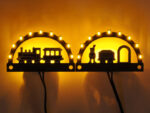Connection for voltage buffers at LGB decoder
Connection at LGB 55021 here we will show some connectivity options for several LGB Decoder. The following must be observed: You should have soldering skill and experience. Disable analogue mode in the decoder. You can solder the cables at bottomside to the corresponding pins. For damage caused by improper treatment, we assume no liability. Connection at LGB OnBoard Big Connection at LGB OnBoard small Connection at LGB 55034 Connection diagram for LGB 55034….


 Deutsch
Deutsch


